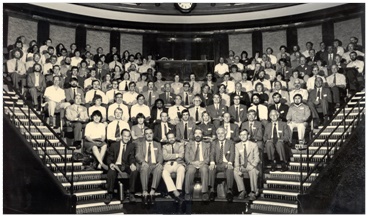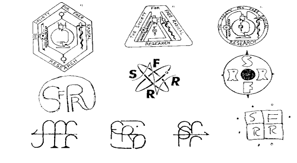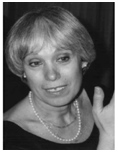A brief history of the Society for Free Radical Research (Europe)
Beginnings at Brunel University in the early 1980’s
The early 1980’s saw a burgeoning of scientific interest and many associated but disparate meetings devoted to free radical chemistry and increasingly covering the potential roles of these species in biology and medicine. The research group in the Biochemistry Department at Brunel University in Uxbridge, UK was very prominent in this area at that time and contained a talented mix of basic and clinically oriented scientists headed by an eminent biochemist, Prof Trevor Slater. Much of their research had focussed on the chemistry, biochemistry and pathophysiology of toxic hydrocarbons, such as carbon tetrachloride where the links between the free radical chemistry and biological effects of these compounds had become clear. The key driver behind the formation, initially of a discussion group, and eventually an international Society was Dr. (subsequently Professor) Robin Willson. Early in 1982, he undertook a survey to determine UK and international interest in forming “an interdisciplinary group to promote discussion amongst chemists, biologists and the medical profession of free radical processes of industrial and medical importance”. This produced a strong and positive response and a new Society was informally formed on 1 April 1982 and initially called the Antioxidant Society (for free radical research). Robin organised an open steering meeting at the CIBA Foundation in Portland Place, London (now the home of the Academy of Medical Sciences) to further gauge the interest in this area and seek widespread views on the format that this new Society and its meetings might follow. A substantial part of the early discussions revolved around whether the group should be independent or develop as part of an existing organisation, such as the Royal Society of Chemistry, Biochemical Society or Society for Chemical Industry, but Robin notes in early discussion papers the international interest and support there was for formation of an international Society and a decision was taken to start such a Society with an inaugural meeting at the Royal Institution, London that was held on 9 July 1982.
Figure 1. Photograph of membership at the July 1982 Royal Institution inaugural meeting |
The Royal Institution was a prestigious and high profile venue for the inauguration and the new Society was grateful to Sir George Porter (then President of the Royal Institution) for providing this venue free of charge. The title of the one day meeting was “Free radicals in industry, nutrition and disease” and it comprised 3 sessions chaired by Prof Alwyn Davies (Professor of Chemistry, UCL), Prof Wolf Bors (Institut for Biologie, University of Munich) and Professor Richard Edwards (Professor of Medicine, UCL). Nine invited talks were given covering topics as diverse as “Lipid peroxidation and rancidity”, “Superoxide dismutase”, “Lipids and prostaglandins” and “Oxygen free radicals, neutrophils and inflammation” and speakers included well known contemporary scientists such as Barry Halliwell, Tony Diplock and Tony Segal.
The programme from the first meeting records that 139 people were registered (see photograph taken at lunchtime) and a key part of the day was given over to an inaugural general meeting that was held at the end of the scientific sessions. At this, Robin Willson gave an update on progress towards establishing the Society and Dr Ivor Capel presented a proposed constitution for the Society.
A key decision taken was that Drs Capel and Willson together with Professor Slater be asked to rapidly organise another meeting to be held by the end of that year and consequently the first Biennial meeting of the Society was held at Brunel University, 15-17 September 1982 with the title “Free radical techniques in industry and medicine”. In the interim between these meetings, nominations were sought for Society Chairman, Secretary and Treasurer and Professor Trevor Slater, Dr. Robin Willson and Dr. Ivor Capel became the first holders of these posts. The programme for the Brunel meeting records that the Antioxidant Society (for free radical research) now had 327 members, “the majority” of whom had already paid their subscriptions.
The Society Name |
The decision also appears to have been taken at this time to hold biennial main meetings of the Society with multiple smaller intermediary meetings. Thus subsequent biennial meetings were planned for the University of York in 1984 and University of Dusseldorf, Germany in 1986. This latter meeting having an organising committee that included Professors Helmut Sies and Hermann Esterbauer. UK research in free radicals must have been very active during this period since smaller one day meetings of the Society were also held at the Whittington Hospital, London (1983), King’s College, London (1983), Guy’s Hospital, London (1984) and the Royal Free Hospital, London (1985).
The Society Logo Figure 2. Ten proposed designs for the Society logo originally published in the Society newsletter - design chosen by the Society is in the centre |
Thus the Society was launched and formed into an organisation which is recognisable today, but a major change was to occur in order to accommodate the increasing size of the Society. In 1988 at the next biennial meeting in Kyoto, Japan a new constitution was developed and adopted and autonomous regional groups: SFRR (Asia), SFRR (Australasia) and SFRR (Europe), inaugurated. The Oxygen Society, founded in the USA in 1987, became a constituent member of SFRR and de facto SFRR (Americas). The Oxygen Society later changed its name to the Society for Free Radical Biology and Medicine (SFRBM).
The parent (international) society has continued the pattern of holding biennial meetings with subsequent meetings in Pasadena, USA (1990); Turin, Italy (1992); Sydney, Australia (1994); Barcelona, Spain (1996); Sao Paulo, Brazil (1998); Kyoto, Japan (2000); Paris, France (2002); Buenos Aires, Argentina (2004); Davos, Switzerland (2006); Beijing, China (2008), Orlando, Florida, USA (2010) and London (2012) while SFRR-Europe moved to hold annual meetings, and a list of the recent venues is shown together with the 15 Presidents that have followed Professor Trevor Slater.
The Catherine Pasquier Memorial Award and Lecture
|
The President of SFRR-Europe from 2001 – 2002 was Catherine Pasquier (right) who tragically died during her Presidency. She was greatly admired and respected by members of the Society for her science, her humanity and her elegance and grace (for a more complete history see Davies et al. “In loving memory” Free Radical Biology and Medicine 34, 1225-1229). To honour and remember Catherine, SFRR-Europe decided to have a Catherine Pasquier lecture at its annual meetings. This lecture is awarded to outstanding younger scientists at the beginning of a professional career who have already demonstrated their excellence. Candidates for the award are proposed by senior members of the society and proposals are evaluated by an independent committee. The winners of this prestigious award are shown in the Table and the Society is proud to have identified at an early stage of their career researchers who have subsequently contributed substantially to our field.
Table 1. List of SFRR-Europe 1982-1984 TREVOR SLATER | Table 2. List of SFRR-Europe 2000 Liverpool, UK |
The SFRR-Europe Summer Schools
An increasingly important role for the Society has become fostering of the careers of young scientists and in 2004, the Society initiated biennial Summer Schools for young researchers (post graduate students and post-doctoral researchers) held at the Spetses Hotel on the idyllic island of Spetses (Greece). The Schools have been planned and organised by different teams of members, but Drs Tilman Grune and Efstathios Gonos have played key roles throughout. The School programmes focus on techniques in free radical biology and medicine and attendance for the majority of the young attendees is free due to sponsorship from the Society and the efforts of the organisers in seeking educational grant support. The Summer Schools have proved incredibly popular with both students and faculty and are structured to allow extensive interaction and discussions. The topics covered have been “Free radicals and diseases: gene expression, cellular metabolism and pathophysiology“ (2004), ”Biomarkers of oxidative stress and responses” (2006), “Lipid peroxidation and free radical signaling: role in pathophysiology” (2008), “Protein maintenance and turnover in ageing and diseases”(2010), and “Dietary factors and redox signalling” (2012).
Table 3. Winners of Catherine Pasquier Award 2004-2022 2004. Helen Griffiths (UK) & Tilman Grune (Germany) |



